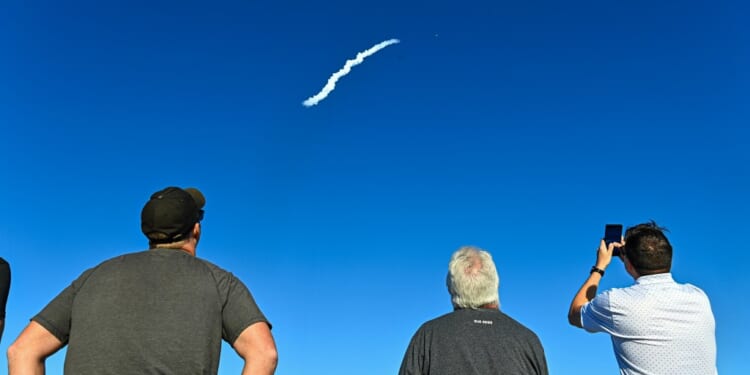
While NASA is a large, sprawling organization, with various objectives and programs, China’s National Space Administration (CNSA) —a civil-military agency of the Chinese government—has been narrowly focused on the moon. It successfully launched the uncrewed Chang’e 1, the country’s first lunar orbiter, in 2007, and six years later, the Chang’e 3 program successfully deployed the first Chinese moon rover. In 2019, Chang’e 4 Yutu rover became the first craft to land on the far side of the moon, in the moon’s southern hemisphere. Then, in 2024, Chang’e 6 ventured to the moon’s far-side region and returned with about two kilograms of rock samples from the area.
Beyond the bragging rights, particularly to Pink Floyd fans, getting to the far side of the moon could unlock access to frozen water, which research has long suggested may exist around the moon’s north and south poles.
China plans to launch Chang’e 7 in 2026 to explore the Shackleton crater in the south pole, a gaping pit about 13 miles across and 2.6 miles deep. The crater’s depth creates several permanently shadowed regions: a classification for areas that sunlight hasn’t touched for eons. As Kevin Wilcox—a senior technical writer for NASA—noted in August 2023, the floor temperature of these craters “could drop below -330°F,” conditions cold enough to freeze liquid nitrogen.
“If you can convert that into oxygen, and convert it into things like rocket fuel, then you can really start to think more seriously about establishing a human presence on the moon, ” Iain Boyd, an aerospace engineering professor at the University of Colorado Boulder, told TMD. Aside from maws like Shackleton, the moon’s south pole also sees proportionally more sunlight than other lunar surfaces: perfect for solar panels.
“I think these things are all technologically doable,” Boyd explained. “You’ve got the ice, you’ve got the water, you’ve got the oxygen, you’ve got the power.”
Todd Harrison, a senior fellow at the American Enterprise Institute who specializes in space policy, agreed, telling TMD, “It’s no coincidence that [China has] been sending missions to that area of the moon. … I think the value of finding and mining that water and converting it into propellant is probably going to be one of the first utilizations of space resources that we see on the moon that becomes economically viable.”
More research is needed to verify the presence of ice water, but China is moving faster toward reaching it than anyone else.
“They’ve achieved a tremendous amount of progress in a relatively short space of time,” Boyd said. “China sees its space program as a public ‘illustration of their technological advances.’” The Chinese Communist Party aims for a “projection of soft power,” and it wants the average “person on the street to hear about China doing science on the moon.”
In the 1960s, NASA was both a demonstration of American power and innovation, but as the decades continued, the appetite for space exploration waned, with incidents like the fatal and avoidable Challenger disaster highlighting a less-favorable image of the U.S. space program. But as the Chinese space program mirrors its country—government-dominated, image-first, aggressively ambitious—America’s space program has turned to its country’s strengths, with private-sector competition around rocketry, and NASA researchers working away quietly on research that could become vitally important.
The current Chinese efforts wouldn’t be possible without NASA’s Lunar Prospector, launched in 1998, which orbited the moon to map its surface and found evidence indicating ice water in areas near the poles. It measured levels of hydrogen that could indicate 6 billion metric tons of frozen water on the surface of the two poles. And in NASA’s fiscal year 2025 budget, the agency requested $341 million for “technology maturation,” including for in-situ resource utilization (ISRU). That includes technology to convert ice water into fuel, as well as other innovations necessary to sustain a prospective moon settlement, such as the potential use of moondust to construct buildings or other material structures.
“For decades, NASA has been pursuing research and funding research across the U.S. on these kinds of very, very specific technologies,” Harrison said. This research doesn’t reveal some secret plan to build an American moon base; any dreams of doing so are spoiled by the extraordinary costs involved with shuttling heavy tools and machinery to the moon via weight-constrained rockets. As Boyd explained, if a nation were to ever build a lunar base for a consistent human presence, it would involve what he called a “layered approach,” where robots would build structures, create water from the ice and oxygen from the water, and then people would follow.
Instead, this research is essentially to ensure that the U.S. is not lagging behind China. “We don’t want to be surprised in five years’ time that suddenly China has landed people on the moon and is taking all that territory for themselves,” he said.
Though delayed, America’s most immediate and ambitious space exploration plan remains NASA’s Artemis III mission. If it launches in 2028, it will try to bring American astronauts back to the moon’s surface—and, for the first time, to the south pole—via the most powerful rocket in history, SpaceX’s Starship. By figuring out how to reuse and refuel components, Boyd said, “SpaceX revolutionized the cost of launching stuff into space.”
Starship isn’t quite ready for prime time yet, though. In the first three of Starship’s five total test launches this year, the spacecraft component temporarily lost communications or control during its return, leading twice to mid-air explosions. While test launches in August and October proved more successful, problems remain, such as how to fuel the world’s largest rocket ship. SpaceX’s solution is to use multiple Starships, assigning one to refuel the other while in Earth’s orbit. However, no rocket ship has successfully refueled another while in outer space. SpaceX is currently designing a newer Starship model, the V3, that SpaceX spokesman Dan Huot said in October features a “complete overhaul” of the spacecraft component to equip it for zero-gravity refueling. SpaceX currently plans a test launch of the Starship V3 to demonstrate mid-orbit refueling sometime in 2026, though the company noted that preliminary test launches of the newer model are needed before attempting the first-of-its-kind maneuver.
The race to the moon is on. And just because Americans landed first, in 1969, that doesn’t mean they can repeat it in the 21st century.

















